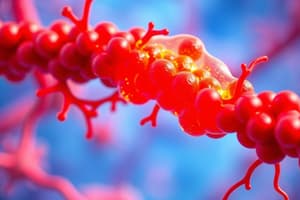Podcast
Questions and Answers
What is the main purpose of respiration in living organisms?
What is the main purpose of respiration in living organisms?
- To generate waste products such as glucose
- To convert water into carbon dioxide
- To convert glucose into oxygen
- To convert stored biochemical energy into a usable form for cells (correct)
Which type of respiration releases more energy: aerobic or anaerobic?
Which type of respiration releases more energy: aerobic or anaerobic?
- Anaerobic
- Aerobic (correct)
- Both release the same amount of energy
- Neither releases energy
In which organisms does aerobic respiration commonly occur?
In which organisms does aerobic respiration commonly occur?
- Animals, humans, and plants (correct)
- Yeast cells
- Microorganisms like bacteria
- Plants only
What is the waste product generated during aerobic respiration?
What is the waste product generated during aerobic respiration?
Which type of microorganisms commonly undergo anaerobic respiration?
Which type of microorganisms commonly undergo anaerobic respiration?
What is the energy currency of cells that is released during aerobic respiration?
What is the energy currency of cells that is released during aerobic respiration?
Where does glycolysis occur in the cell?
Where does glycolysis occur in the cell?
Which stage of cellular respiration relies on the electron transport chain (ETC)?
Which stage of cellular respiration relies on the electron transport chain (ETC)?
What is the main purpose of the Citric Acid Cycle (Krebs Cycle)?
What is the main purpose of the Citric Acid Cycle (Krebs Cycle)?
Which cellular process is essential for maintaining membrane potentials?
Which cellular process is essential for maintaining membrane potentials?
Which respiratory adaptation is found in fish and aquatic invertebrates?
Which respiratory adaptation is found in fish and aquatic invertebrates?
What is the primary function of respiration for organisms?
What is the primary function of respiration for organisms?
Flashcards are hidden until you start studying
Study Notes
Life Processes: A Focus on Respiration
Life is a dynamic and interconnected web of processes that enable organisms to grow, reproduce, and maintain themselves. This article will dive into one of the fundamental life processes, respiration, to understand how it contributes to the wellbeing of living organisms.
What is Respiration?
Respiration is the process by which organisms convert biochemical energy stored in molecules into a form that cells can use to carry out essential functions. It involves the breaking down of molecules, such as glucose, to release energy and generate carbon dioxide (CO₂) and water (H₂O) as waste products.
Two main types of respiration occur in living organisms:
-
Aerobic Respiration: This process occurs in the presence of oxygen (O₂) and releases more energy than anaerobic respiration. Aerobic respiration occurs in organisms like animals, humans, and plants. It converts glucose into carbon dioxide and water while releasing a large amount of adenosine triphosphate (ATP), the energy currency of cells.
-
Anaerobic Respiration: This process occurs in the absence of oxygen and releases less energy. Anaerobic respiration is common among microorganisms like bacteria and yeast, and some plant cells. During anaerobic respiration, glucose is broken down to produce lactic acid or alcohol.
The Process of Respiration
The respiratory process involves three main stages:
-
Glycolysis: Occurs in the cytoplasm and is the first phase of cellular respiration. It breaks down glucose into two molecules of pyruvate, generating a small amount of ATP and two molecules of nicotinamide adenine dinucleotide (NADH).
-
Citric Acid Cycle (or Krebs Cycle): Occurs in the mitochondrial matrix and is the second phase of cellular respiration. In this stage, pyruvate molecules are broken down to generate more ATP and NADH. Additionally, this process produces a molecule called fumarate.
-
Oxidative Phosphorylation: Occurs in the inner mitochondrial membrane and is the third phase of cellular respiration. This stage relies on the electron transport chain (ETC) to transfer electrons from NADH and fumarate through a series of electron carriers, ultimately releasing energy that is captured by ATP synthase to generate ATP.
Why Is Respiration Important?
Respiration is a critical life process, as it provides energy for cellular functions, such as:
- Synthesizing new molecules
- Maintaining cellular structures
- Contracting muscles
- Transmitting nerve impulses
- Maintaining membrane potentials
- Transporting substances across cell membranes
Without respiration, cells would be unable to generate the energy they need to function and survive.
Respiratory Adaptations
Organisms have evolved various strategies to optimize their respiration and ensure they take full advantage of their environment. Some examples include:
- Gills in fish and aquatic invertebrates, which facilitate oxygen absorption and carbon dioxide excretion in water.
- Air-breathing lungs in vertebrates, which facilitate oxygen absorption and carbon dioxide excretion in air.
- Tracheae and tracheoles in insects, which facilitate oxygen absorption and carbon dioxide excretion in air while also delivering oxygen and nutrients to cells.
Conclusion
Respiration is a fundamental life process that enables organisms to convert the energy stored in molecules into a form that cells can use. It provides energy for cellular functions and is essential for growth, reproduction, and the maintenance of living organisms. Understanding respiration and its importance is a critical component of understanding the complexities of life.
Studying That Suits You
Use AI to generate personalized quizzes and flashcards to suit your learning preferences.




